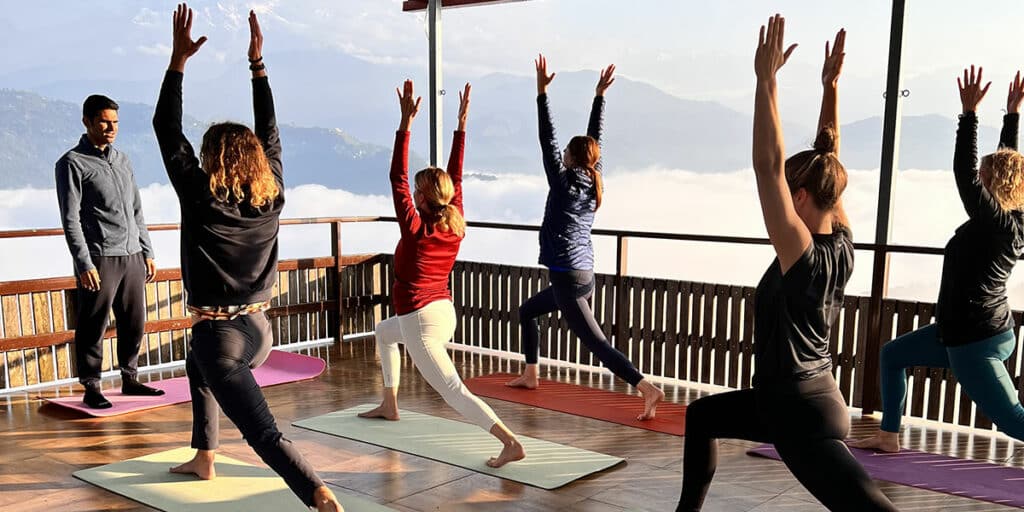HOW TO CHOOSE A YOGA TEACHER TRAINING PROGRAM
by Soha Akbar

After enjoying the benefits of Yoga in one’s self practice, many of us want to embark on a journey of passing on the yogic teachings to others. And then comes the time to choose a teacher training program. Though it must be mentioned that a teacher training program, or TTC, does not only help when teaching others but also serves as a means to deepen one’s own practice. So, once we decide to pursue a TTC, where do we start?
A simple Google search for ‘yoga teacher training course’ will reflect hundreds, if not more, options for various schools, teachers, methodologies, certifications, etc. Hatha? Ashtanga? 200 Hrs? 500 Hrs? Residential? Non-residential? And the list goes on and on. Sometimes it can be overwhelming. Hence, before we zero in on a particular course just by googling the options, it is essential to figure out what exactly we want or expect from the course. Here we are sharing some important points to consider when choosing a Yoga TTC.
Intent or objective: To begin with, there is no right or wrong intention to enrol in a Yoga TTC. However, it is important for choosing the right kind of program. Are you expecting to deepen your own physical practice, teach others or simply expand your knowledge of Yoga?
Style: One needs to decide which style of Yoga TTC they want to do. Some popular TTC styles are traditional Hatha Yoga, Ashtanga Vinyasa Yoga, Yin Yoga and Aerial Yoga. Further, within Hatha Yoga, you have different options like the Iyengar methodology, the Sivananda style, etc. One may also choose to go for TTCs focusing on certain aspects of health, like Yoga Nidra, Prenatal and Postpartum, Yoga Therapy, Pranayama and meditation etc. The outcome for each of these options is different, so understanding the differences between them is a good starting point.
Certification and duration: Traditionally, Yoga teachings were passed down from teachers to students in a Gurukul setting, which did not have a specified time limit. The student or shishya studied under the teacher or guru for as long as deemed necessary by the teacher. Actually, there was no concept of formal teacher training programs. Only a handful of extremely dedicated students left their homes to go live with the Guru in the ashram, and learn about Yoga by making it a way of life. This was, of course, before Yoga spread far and wide as a form of holistic fitness.
Over the years, with thousands of practitioners wanting to teach, formal schools and institutions have been set up which provide certifications. Most of these schools are affiliated to a governing body like the Yoga Alliance or AYUSH that provides a framework for the course requirements. The most common international certification is Yoga Alliance which requires a licensed teacher to have either 200 hrs, 300 hrs or 500 hrs training. The course duration depends on the training hours. Some schools provide TTCs independent of the 200/ 300/ 500 hrs schedule as well. In that case, the duration of the course is at the school’s discretion.
The 500-hour training will almost always have more in depth study and practice modules when compared to the 200-hour training. How long we can invest in a TTC is a personal call and an important one at that.
Residential program vs online training: Post the pandemic in 2020, many schools pivoted to teaching TTCs online, and since then have continued providing online courses along with residential programs. The in-depth immersion in residential programs remain unmatched, but online TTCs have proven to be convenient for yoga teacher aspirants that, for various reasons, cannot leave home or a regular job for a month and attend the training.
Furthermore, online trainings can be either live or pre-recorded, self-paced or time bound. Here, too, we can narrow down our choice of school by carefully considering the pros and cons for each option.
Curriculum: Whether you choose an offline TTC or an online one, the curriculum is of utmost importance. Does it comprise all the topics you want to learn? Does it cover important topics like functional anatomy and Asana modifications, or does it have a ‘one size fits all’ approach? Does it provide opportunities for hands-on teaching practice? Is the learning intensive or non-intensive? Is the curriculum well-structured and easy to understand? There is no point in attending a TTC only to come of it feeling confused and inadequate.
Faculty: All said and done, the teachers form the backbone of a learning program. Research a bit about the program’s teachers, their Yoga education and teaching experience, their teaching methodologies, etc.
Budget: Affordability is a huge aspect when considering TTCs. The course fee depends on various factors like program duration, certification, teachers’ experience, residential facilities, etc. Online options are almost always cheaper than residential programs of the same school.
It is also important to know that you won’t always start earning good money as a Yoga teacher right after the program; there are often no guarantees of how much money you will make, and the income might not be consistent. So, you need to be realistic about the money you can spend on the program if you are expecting to earn it back right away.
Support and mentorship: Another factor we can take a look at is if the school provides post-training support and guidance to its TTC students, and provide a platform for them to communicate with the faculty regarding teaching or practice related queries. A good example of such a platform is a Facebook community.
Reviews and testimonials: Online reviews from previous students also help us understand the overall competency of a school or a training program. Even though it is not a fool-proof method of selecting a school (unfortunately, fake reviews and paid reviews are prevalent), it can give us a general idea of the students’ experience.
A teacher training course is not merely a sum of the points discussed above, or a piece of certification. It is a tool to empower oneself and others. It is a journey of self-discovery as well as a service through educating and teaching others. This journey has the potential to be life-changing, for both the teacher and the students. Remember, being able to choose a program that is the best fit for you can make all the difference!
About the Author

Sohaila Akbar
Sohaila is a Yoga teacher, keen on bringing about positive changes in the lives of others through the knowledge that she has received from her teachers. Prior to this she was a school teacher working towards imparting academic, social and ecological knowledge to young learners. Sohaila is an avid reader of books and have an undying love for fiction. She prefers paperbacks and hardcovers over e-books anyday. She loves travelling, and a good cup of coffee is always welcome!
